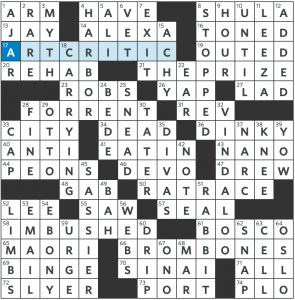 (4.28 avg; 25 ratings) rate it
(4.28 avg; 25 ratings) rate it
Patrick Berry’s Wall Street Journal contest crossword, “One-Word Answers”—Laura’s review
This week, we seek a place where you might give one-word answers. Let’s go look.
Right off the bat, I noticed that every entry in the grid is a single word, except for the longer theme entries:
- [17a: Judge who’s often in the gallery?]: ART CRITIC
- [21a: 1963 spy film starring Paul Newman as a Nobelist]: THE PRIZE
- [28a: Apartment window sign]: FOR RENT
- [41a: Enjoy home cooking]: EAT IN
- [50a: White-collar daily grind]: RAT RACE
- [58a: “It’s been a long day!”]: I’M BUSHED
- [66a: Member of a Sleepy Hollow love triangle]: BROM BONES
First observation: Both two-word entries I’M BUSHED and BROM BONES can become one-word entries when you change the first letter: AMBUSHED and TROMBONES, respectively.
Aha! Maybe you can change the first letter of each two-word entry to make a one-word entry? Turns out, not necessarily the first letter, thusly:
ART CRITIC == ARTHRITIC
THE PRIZE == THEORIZE
FOR RENT == TORRENT
EAT IN == SATIN
RAT RACE == RETRACE
I’M BUSHED == AMBUSHED
BROM BONES == TROMBONES
The changed letters spell out HOT SEAT, which I suppose is a place where you might give one-word answers. Yes? No? Five?
What’s particularly elegant — almost easter-egg-ish — about this mechanism is that changing the letters in those across entries also results in perfectly cromulent down entries at those crossing points, respectively:
HARRYING
STOOPED
TINE
BEDS
DIVES
LAMBS
WETS
The puzzle becomes, in essence, a one-word entry themeless. Very nice! Anyway, I’m bushed, or I’d write more. Let’s have Bing Crosby as BROM BONES — the Gaston of his day — sing us out:

Enjoyed the puzzle but did not solve this elegant meta. They often seem so obvious on reflection.
Very fun meta, right in the sweet spot of challenging but not too difficult for me. And an impressive feat of design since, as Laura noted, all of the Down answers are still coherent after the letter change.
This is not a ding — the puzzle is as amazingly elegant — but making the crossing entries after substitution valid entries is necessary. It’s the cross-checking mechanism to validate, for example, that EAT IN becomes SATIN and not LATIN.
Patrick Berry’s metas are unbelievably smooth. The commenter above me nails it: “amazingly elegant”.
I wish the title had been a little less of a giveaway (“And Now, A Word…” perhaps?) but that’s a small complaint.
Agreed on both counts. I’m in awe of PB’s ability to design these – constructing any puzzle seems difficult enough, but adding all these layers on top of it shouldn’t be possible.
My favorite Patrick Berry puzzle is a cryptic-style meta-ish puzzle called Middle of the Road. Extremely challenging, but the payoff is worth it.
I loved Middle of the Road, too. Have you tried Taking Turns, from the 3rd crypt on his site? It was another spectacular puzzle.
No, but I think I know what I’ll be doing this weekend now. Thanks!
Thank you for recommending the Middle of the Road puzzle. I just finished solving it and I’m sitting here in awe of this amazing feat of construction. It might be the best puzzle I have ever solved. Wow.
Could anyone help me parse the cryptic clue for Column 11?
11. Repel endless group of fighters standing opposite
“Fighters standing opposite” = FOES (Definition)
Turn backwards (“Repel”) SET-T (“endless group”) + OF (“of”)
I agree, I solved this puzzle about a month ago and I am still amazed by what he was able to accomplish with it.
Thank you for this explanation. That sneaky OF got me! The fact that this puzzle was an homage to Mad Magazine — on too of all the other layers — really blew my mind. I can’t even begin to imagine how a constructor would plot out this kind of creation … and then make it all work.
I had the same feeling when finishing it. I must have sat there speechless for minutes while I considered everything that went into constructing that puzzle. There’s even a small Easter Egg with the letters left over at the end.
I also couldn’t parse that specific clue, so thanks to Joseph for clearing that up.
This puzzle does seem very elegant, as others have mentioned.
Is it also difficult to create a puzzle entirely out of one word answers? Seems like it to me but I’m not a constructor.